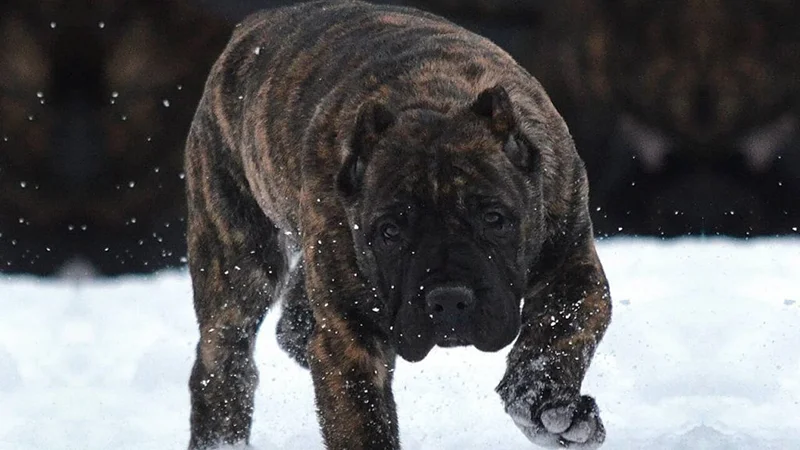The Presa Canario is a large Molosser type dog breed originally bred for working livestock. They are great family protectors and are born to be family companions as well as guardians.
Do you interested in this breed but are unsure if it is right for you? Find out everything you need to know about the Presa by reading on.
Let’s see together…
Content Overview
- History
- Different names
- Appearance and Characteristics
- Personality and Temperament
- Health & problems
- How to take care
- Puppy Information
- Puppy price
- Things to consider adopting a puppy
- Advantages & Disadvantages
- Questions related to the Presa Canario
- Photo gallery
History of Presa Canario
There are several theories regarding the genetic contributions to the creation of the Presa Canario. Many local stories date from the 15th and 16th centuries that feature the Molosser breed dogs on the island, the Presa Canario included. They used to guard farms, wrangle cattle and drive off or kill other stray wild dogs.
They were the first bred in the Canary Islands during the 19th Century for dogfighting, guarding, and herding.
Today, Perro de Presa Canario primarily use as a guard or companion dog.
The Perro de Presa Canario has been recognized worldwide through the sad truth that its celebrity status is mainly by the negative press it receives. In the 1940s, dogfighting prohibition was ordered throughout the islands, although clandestine fights continue during the next decade. It was during this period the Presa Canario numbers indeed faltered.
In the 1940s, this breed began to decline in numbers. It was revived again in the 1970s when reputable breeders developed and bred Presas true to their original size and character. United Kennel Club recognized him on January 1, 2003. Reputable breeders bred strong Presa that was rustic, massive, vigorous, and functional who had acute watchdog instincts, a strong temperament, calm yet confident, and were highly territorial with unlimited courage.
Different names or Types
Other names
- Perro de Presa Canario
- Dogo Canario
- Canary Dog
- Presa
- Canary Mastiff
- Canarian Molosser
Recognition
- United Kennel Club – UKC
- American Pet Registry, Inc. – APRI
- American Canine Association – ACA
- Dog Registry of America, Inc. – DRA
- Fédération Cynologique Internationale – FCI
- North American Purebred Registry, Inc. – NAPR
- American Kennel Club Foundation Stock Service® Program – AKC/FSS
Appearance & Characteristics
The Presa has a massive head, heavy rectangular body, and a short coat in brindle, black, fawn, or any combination of those colors.
Breed basic characteristics
| Origin | Spain (Canary Islands) |
| Group | Mastiff |
| Size: | Large |
| Lifespan: | 9-11 years |
| Trainability: | Moderately Easy Training |
| Exercise Needs: | Daily, long walk |
| Grooming: | Low Maintenance |
| Barking: | Occasional |
| Shedding: | Moderate to average |
| Protective Ability: | Not Good with Kids |
| Brushing: | Brush once or twice a week |
| Hypoallergenic Breed: | No |
| Space Requirements: | Large space |
| Compatibility With Other Pets: | No |
| Average Puppy Price: | $800 to $1,250 USD |
| Height | 22-26 inches |
| Weight | 84-110 pounds |
| Litter size | 7 to 9 puppies |
Sound Behavior
Calm appearance and attentive expression are especially suited to guarding and are traditionally use for herding cattle. Balanced temperament and very self-confident. Low and deep bark.
Size, Proportion, Substance
Size: Desirable height at withers for a mature male is 23-26 inches. The desirable height at withers for an adult female is 22-25 inches.
Proportion: A moderately sizeable-sized molossoid, with a rectilinear profile and black mask. Robust and well proportioned.
Appearance
Head: The head is massive and cuboids in shape. When viewed from the side, the top lines of the skull and muzzle are roughly parallel to one another and are joined by a well-defined but not abrupt stop.
Muzzle: Their muzzles taper slightly to the nose, with the bridge being straight and flat.
Jaws/Teeth: A maximum of two millimetres of undershot or scissor bite Despite its acceptance, the dental erosion that results from a pincer bite is not desirable. He has a complete set of evenly spaced teeth set in a wide jaw. A scissors or reverse scissors bite is preferred. The canine portion of the dental arch is wide. The teeth are solidly anchored and wide. Canines with good development, small incisors, and large molars.
Serious Faults: Blue, gray, or yellow eyes, non-matching eyes.
Skull: Transversal and anteroposteriorly slightly convex. The frontal bone usually has a flat shape. The width and length are nearly identical. pronounced zygomatic arch, with loose skin and well-developed but not prominent cheek and jaw muscles. The occipital protrusion is barely visible.
Stop: The stop is noticeable, but it is not abrupt. Between the frontal lobes, there is a well-defined furrow that is approximately two-thirds the size of the skull.
Nose: Strong, extensive black pigmentation. parallel to the muzzle. To make breathing easier, the nostrils are large.
Lips: Although not excessively pendulous, the upper lip is pendulous. The upper and lower lips form an inverted V when seen from the front, and the flies are slightly different. A dark colour coats the lips’ interior.
Eyes: Oval in shape, ranging in size from medium to large. Separated well, but not submerged or protruding.
Eyelids: Eyelids are black, form-fitting, and never sag. Depending on the coat colour, the colour ranges from dark to medium brown. They shouldn’t be light at any time.
Ears: Medium-sized, well-defined, and sporting fine, short hair. Each side of the head naturally receives them. They have the appearance of a rose when folded. They are set a little bit higher than eye level. It is unusual to have ears that are set too high and too close to the head. They must stand erect in countries where cropping is permitted.
Croup: Broad, rounded, and of medium length. should not be lengthy because it would restrict movement. Typically, the female is wider.
Chest: With well-defined pectoral muscles and a lot of capacity It ought to be let down to at least the elbow when viewed from both the front and the side. Typically, the thoracic perimeter is equal to 45 percent more than the withers’ height. Rib cage with a good spring
The belly and underline: A little bit tucked in but never sagging. The flanks are barely noticeable.
Tail: The base is thick and tapers to the tip before ending at the hock. Set to medium. When in use, it rises like a sword without bending or leaning back. It hangs straight at rest, with a small curve at the tip.
Skin: Flexible and thick. On and around the neck, looser. Skin on the head has symmetrical wrinkles that spread out from the space between the front lobes when the animal is alert.
Neck, Topline, Body
Neck: The neck is cylindrical, thick, well-muscled, and slightly shorter than the head’s length. The underside has loose skin that forms a slight dewlap. It tends to be cylindrical and muscular, solid, and straight.There is a loose fold of skin on the neck for a slight overlap.
Topline: The top-line is sloping with the rear little higher than its shoulders, and its body is a little longer than it is tall. Straight, without any deformations, and supported by muscles that are well-developed but barely noticeable. From the withers to the croup, a slight rise Between 1 and 2 centimetres more height is present at the croup than at the withers.
Body: Deep, wide, and long. The body is longer than the withers’ height; this characteristic is more noticeable in the female.
Forequarters
Shoulders: Very relaxed. Shoulders are muscular and well laid back. The upper arm is of a good length and well-angled so that the front legs are set well behind the shoulder’s point.
Upper arm: Oblique, well angulated
Forearm: Symmetrical and straight. well-muscled and with solid bones.
Elbow: Must not be too close to the ribs or protrude too far.
The Pancreas’s metacarpus: Very sturdy with a slight slope.
Forefeet: Toes on cats’ feet are round and not too close together. Black, well-developed pads. Despite the fact that white nails can occur due to coat color, dark nails should be avoided.
Front legs: Front legs are straight, well-muscled, and heavy-boned. Pasterns are strong, short, and nearly vertical.
Hindquarters
Appearance in general: Viewed from behind, strong, parallel, and defiant.
Thigh: Long and all-around ripped thighs.
Knee stiffener: Although not particularly pronounced, angulation should not be insufficient.
Metatarsus (Rear pastern): Always disappointed.
Hind feet: Although otherwise identical, the front feet are slightly longer.
Coat
The Presa Canario has a smooth coat that sheds. Brush him at least once a week to remove dead hair and keep the skin and coat healthy. Clean the ears and trim the nails as needed and bathe the Presa on the rare occasions that he’s dirty.
Color and Markings
All shades of brindle from warm dark brown to pale grey or blond. All shades of fawn to sandy. White marks are acceptable on the chest, at the base of the neck or throat, forefeet, and toes of hind feet, but these should keep to a minimum.
Movement and gait: The Presa Canario should cover a lot of ground while moving because it is supple and agile. a long reach The head is only slightly elevated above the level of the back, and the tail is carried low. The head and tail are carried high when alert. When trotting, the stride is long, effortless, and well-coordinated, and the tail carried above the top-line.
Personality and Temperament
Personality
This Perro de Presa Canario is large, powerful, intelligent, and headstrong. The breed standard says he should be calm, attentive and self-confident, obedient, docile with family members, and suspicious of strangers. He is powerful and remarkably well-muscled.
Temperament
They are great family protectors and are to be family companions as well as guardians. The Dogo Canario’s calm appearance, obedient and affectionate nature is reserved only for the family members as beneath it lays a fierce, courageous protector who does not fear encountering a situation of any kind. Presa Canario’s require a very dominant owner and recommended for first-time dog owners. He can be highly dangerous if placed with the wrong owner.
Activity Requirements
The Presa Canario has a high activity level and needs a job to do, which can be anything from being your on-leash walking companion to daily training activities. These territorial dogs are noted for their high prey drive since they were traditionally employed to guard livestock hence not being an excellent choice to keep with other dogs and smaller pets.
Behavioral Traits
The Perro de Presa Canario is naturally protective and suspicious of strangers, so it makes a good guard dog. It is essential to be careful with this breed around cats and other pets because it has a high prey drive and solid territorial instincts.
Trainability
They require a good deal of commitment and patience, and trainers will need to assert their dominance and not tolerate any bad behavior. Training of the Presa Canarios requires a firm and consistent method. He can be challenging to train as the breed can be willful and dominant.
Health & problems
Perro de Presa Canario Health & Problems
All dogs have the potential to develop genetic health problems, just as all people have the potential to inherit a particular disease. One of Perro de Presa Canario breeders’ most significant concerns is hip dysplasia, a hereditary condition that affects many large dog breeds. The breed may also be prone to gastric torsion/bloat and anterior cruciate ligament tears. Ask the breeder to show evidence that a puppy’s parents have hips rated as fair, reasonable, or excellent by the Orthopedic Foundation for Animals.
Feeding Plan
Perro De Presa Canario pups should probably be given excellent-quality, name brand puppy food. Premium-quality dry dog food ensures balanced nutrition for grown Perro de Presa Canario and can mix with canned food, broth, or water.
Feeding a dog fruit and vegetables is sort of a “hit or miss” as not every Presa will eat fruit or vegetables. A simple trial and error experiment will help you find out what kinds of fruits or vegetables your dog likes.
- Perro De Presa Canario puppies between eight and 12 weeks old need four bowls of food in a day.
- Feed Perro de Presa Canario puppies 3 to 6 months old 3 meals daily.
- Feed puppies 6 months old to 1-year-old two times each day.
Here is the recipe how to feed your dogs.
Adult female Presa over 2 years old eats 2 lbs of food 2 x a day. Total of 4lbs per day.
Male Presa eats 2-1/2 to 3 lbs of food 2x a day. Total of 5 lbs per day.
Breakfast:
1-1/2 lbs of raw meat,
10 oz of fully cooked rice
3 tbsp of carrot puree
100 mg of vitamin C
200 IU of vitamin E, or 1 tbsp of cooked livers
1/2 cup of milk
1 tbsp of oats soaked in milk
Dinner:
1-1/2 lbs of raw meat,
10 oz of fully cooked rice
2 tbsp of berries
100 mg of vitamin C
6 drops of fish oil
8-10 drops of liquid vitamin B complex
1 tsp of dry kelp (dust form for better digestion)
Living conditions
The Presa Canario needs a lot of space to run and plenty of work to keep them busy. They are not suitable pets for first-time dog owners or people with small children or other pets unless they are adequately trained. If He will spending a lot of time outdoors, make sure he has access to covering and plenty of cool water in hot weather and a covered dry, warm shelter when it’s cold.
How to take care?
Owning dogs, especially taking care of the Perro de Presa Canario, is a speciality of people worldwide. He is also a popular choice among dog owners. Many owners are unaware of however many of the most crucial his care tips. Here are we provide some essential tips on how to take care of him.
Exercise
Perro De Presa Canarios must get exercise to stay fit, recharge their minds and maintain their health. The daily routine also seems to help him to avoid boredom which would often lead to naughty behaviour.
Grooming & Bruising
The Presa Canario is known for minimal shedding. This coat is also straightforward to groom. Use a firm bristle brush, and then as a finish, you can wipe the skin with a towel. You can help keep your dog clean and reduce shedding with frequent brushing. Inspect for ticks and fleas daily during warm weather.
Dental Health check up
Dental disease is the most common chronic problem in pets affecting 80% of all dogs by age two. And unfortunately, your Presa Canario is more likely than other dogs to have problems with her teeth. It starts with tartar build-up on the teeth and progresses to infection of the teeth, gums, and roots.
Proper dental health care is essential for every dog; similarly, it is necessary for the Presa Canario dog. Brush your dog’s teeth at least 2 or 3 times a week. You get a special toothbrush for dogs, and a vet can guide you on how to use them. If you don’t attend to your pet’s teeth, he can experience tartar build-up. It can lead to gum disease and tooth loss. Not only that, bad teeth can affect other parts of the body too.
Love & affection
Love and affection are beneficial for every dog. Suppose you give love and respect to your dog, then the dog will love you back. Your puppy will be a member of your family, So Give lots of love and affection to your cute puppy. Most importantly, spend time with your dog because that your dog needs love and affection.
Feed Healthy food
Feeding healthy food in the dog’s life is the most important. These days, there are many healthy foods available on the market so that you can choose any healthy food for your dog. Because healthy food is the most important for dog health cares. The young dog is not a hearty eater as most breeds his size. He must often encourage meat juices or bacon grease mix in the food to entice him to eat.
The Presa should do well on high-quality dog food, whether commercially manufactured or home-prepared, with your veterinarian’s supervision and approval. In general, American Staffordshire Terriers need a high protein, low grain diet, which helps prevent diarrhoea and bloat; always make sure that they have clean, fresh water for drinking. However, their diet needs, including the amount and frequency you feed them, will change over time as they age.
Feed your puppy several times a day so they can grow up to be big and strong. Don’t forget to provide your dog with plenty of exercises to keep them from becoming overweight or obese.
The following items should never be feed to Presa Canario
- Alcohol, beer, wine or liquor
- Chocolate, coffee, or tea
- Grapes or raisins
- Moldy or spoiled food of any kind
- Onions, chives, and garlic
- Poultry bones
- Salt & salty foods
- Tomato leaves stem or unripe fruit
- Yeast dough
Puppy information
Puppy Training
The Perro de Presa Canario is an intelligent and trainable breed, but it can sometimes be challenging to handle due to its massive size and independent will. He is a very reliable watchdog, and he can also be an excellent companion for the entire family. The single most crucial aspect of puppy training is that you reward and praise your puppy every time she does the right thing.
Training your puppy dog is not an easy job for first-time dog owners. This breed requires a very stern owner and can give a decent amount of time to every day and reoccurring training lessons.
Crate training
Crate Training is one of the most efficient and effective ways to train a Presa Canario puppy. It can be an efficient and effective way to house train a Canario puppy. Puppies do not like to soil their resting or sleeping quarters if given adequate opportunity to eliminate elsewhere. Crate training also helps teach your Canario puppy to have bladder and bowel control. Instead of going whenever she feels like it, she learns to hold it and go at conveniently scheduled times.
Presa Canario Behavior training
Before teaching its basic commands, it is essential to establish a close emotional relationship between the dog and the owner. Behavioural training is necessary for any dog. All of us, dog owners, need to administer some dog behaviour training at some point in time. Behavioural training is beneficial for taking care of the dog. If you want to train your puppy to behavioural training, find some common behavioural issues like breaking, aggression, food guarding, howling, mouthing and chewing, separation anxiety, etc. and stop all these behavioural issues and train your dog efficiently.
Obedience training
Take your Presa Canario puppy and adult obedience classes. At the same time, basic training is required for this breed. Train your Canario puppy using only positive, reward-based techniques and punishment-based training can encourage and foster aggression in this breed. Enrol your puppy in the AKC’s Good Citizen Program to ensure your dog is polite and well-behaved at all times. He is also impressed by potential landlords and insurance companies. It makes your dog a breed ambassador, showing others in your community that the pit bull can be well-behaved and well-mannered.
Socialization
Presa Canario requires early socialization and obedience training in some situations, the Presa can be aggressive toward other dogs and suspicious of strangers. Socialize your Presa Canario puppy from a young age of 7 weeks. Expose your new dog of any age to as many other dogs and people as possible, making all of these experiences positive ones involving play and dog treats.
Presa Canario puppy price
The cost to buy a Presa Canario varies greatly. It depends on many factors such as the breeders’ location, reputation and litter size, the lineage of the puppy, breed popularity, training, socialization efforts, breed lines and much more. Review how much your puppies for sale sell for below.
The current median price for all Presa Canarios sold is $1,200.00. You should budget anywhere from $3,500 upwards to $7,500 or even more for a Presa Canario with top breed lines and a superior pedigree. The average cost for all Presa Canarios sold is $1,300.
Things to consider adopting a Presa Canario
Suppose you are a confident dog owner and are looking for an active, intelligent and protective dog to keep you accompany. In that case, the American Staffordshire Terrier temperament may suit you perfectly.
If you’re seriously considering adopting an American Staffordshire terrier, you should know all this.
- Before you adopt Presa Canario, consider how much time your new family member will spend alone. Remember, a puppy requires constant attention.
- Before you adopt a puppy, ask yourself if you are available to walk along with your dog several times throughout the day.
- You also have the advantage of knowing that your dog is physically able to “hold it” for several hours at a stretch.
- Ask anybody who has adopted an adult dog, then adopts an adult dog.
- If you’re not sure whether the new dog you’ve chosen is right for your family and lifestyle, consider fostering before committing.
Advantages of Presa Canario
- They have low maintenance coats.
- They make good family pets in households with older children.
- Presa Canarios are loyal and devoted by nature.
- They are good “natural” watchdogs.
Disadvantages of Presa Canario
- They have a very high prey drive.
- They can be stubborn and willful when it suits them.
- Presa Canarios are not the best choice for first-time dog owners.
- They are not a good choice for families with toddlers or younger children.
- They are extremely powerful dogs when fully mature.
Questions related to the Presa Canario
1. What is the bite force of a Presa Canario in pounds?
540 PSI
2. Is the Presa Canario dangerous?
When properly bred, this breed is widely regarded as an excellent guard dog and devoted pet. However, if it is not properly trained, it has a reputation for being an intimidating fight dog with an aggressive streak. Sadly, Presa Canario attacks are common and can result in fatalities.
3. Is Presa Canario a good dog for the family?
They are an incredibly loving variety. They appear tough and can act distant from people they don’t know, but they care a lot about their family.” Even though he adores his human family, the majority of Presa Canaries would rather be the only dog in the house.
4. Are Presa Canaries beneficial for new owners?
If you’re a first-time dog owner or a family with young children, this is definitely not the best option. The Perro De Presa Canario can become overly aggressive if it is not properly trained.
5. Is a Presa Canario a good dog for the family?
They are a breed that is extremely affectionate. They look intense and can act unapproachable toward outsiders, however they are exceptionally friendly to their loved ones.
6. Is it hard to train Presa Canario?
One breed of Presa Canario can be extremely challenging.
7. Is Presa Canario a decent gatekeeper or guard dog?
The Presa Canario is primarily a guard dog. It is smart, curious, and wary of new people. When properly bred, this breed can bond strongly with humans and will be calm and attentive.
Presa Canario photo gallery
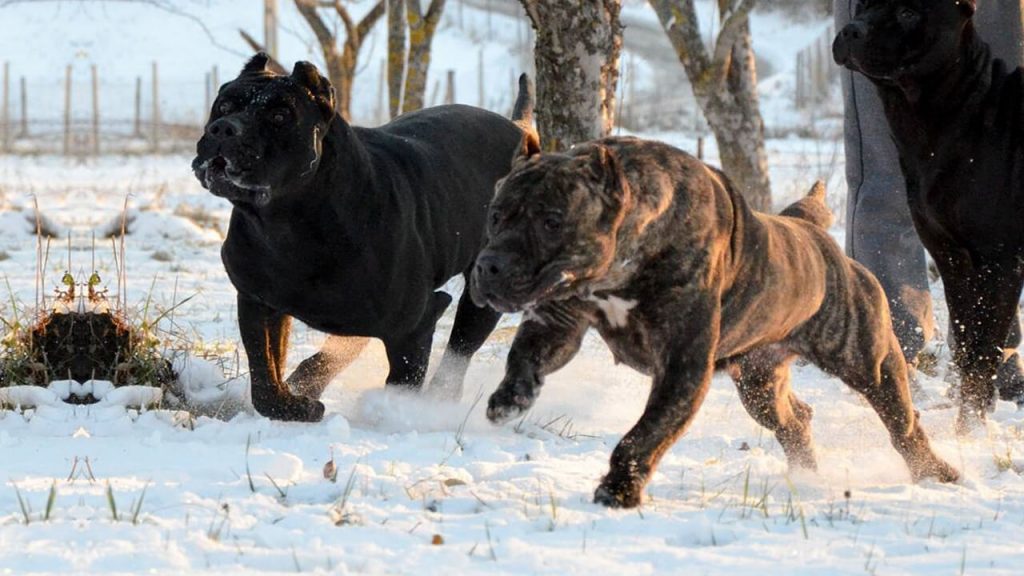
Credit: @carpatcan
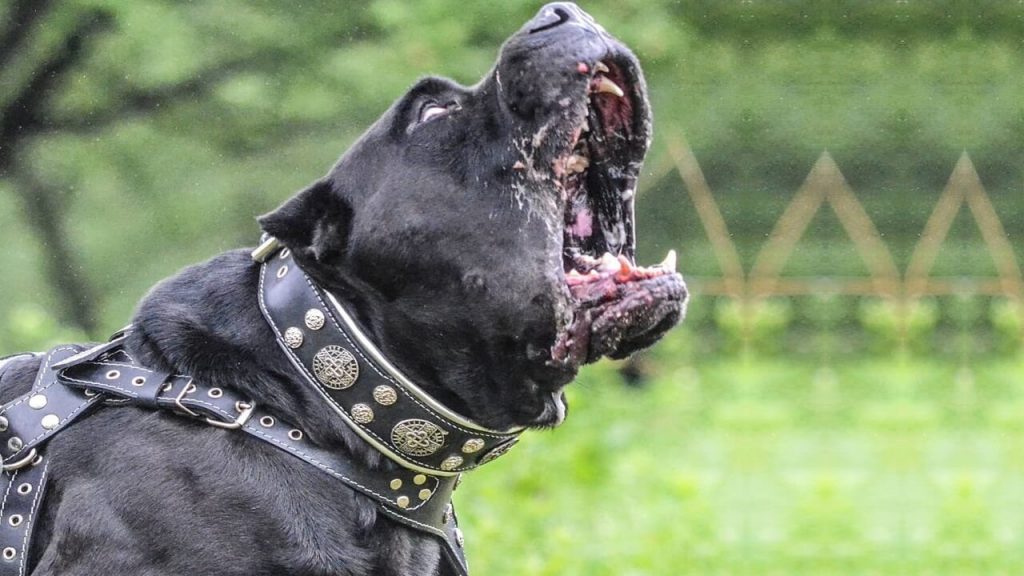
Credit: @carpatcan
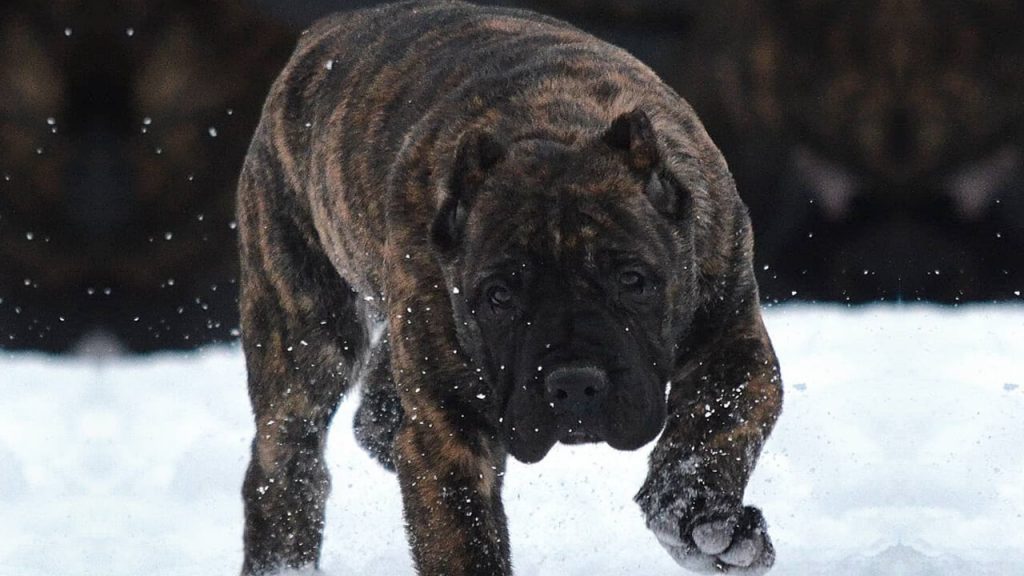
@carpatcan
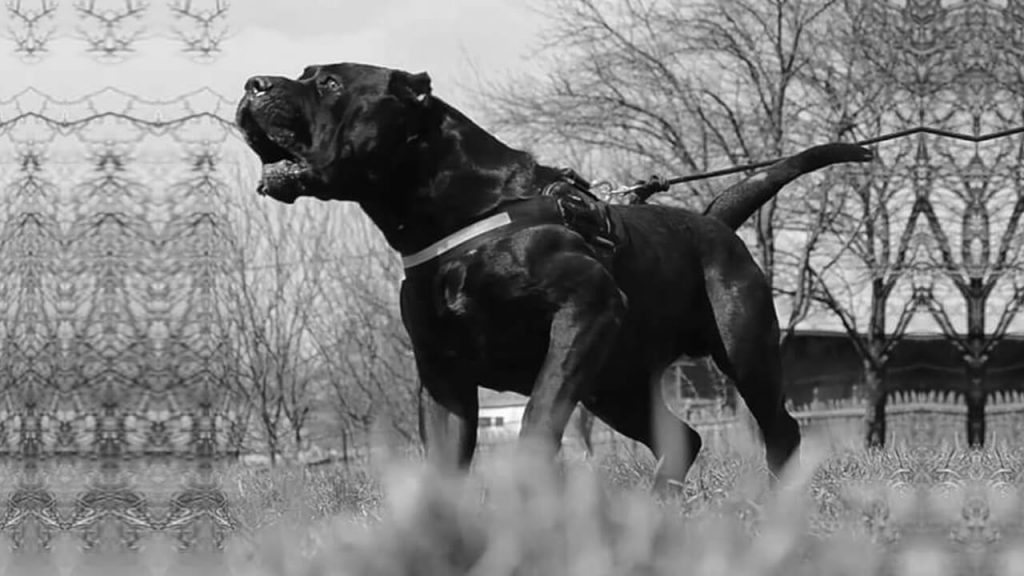
Credit @carpatcan

Credit @carpatcan
Got some questions? Or some suggestions? That’s why we’ve got a comments section on this blog! You can feel free to leave a comment or two down below and we’ll get back to you as soon as possible!
We love reading your messages……
Also read: Top 10 benefits of having a Beagle
